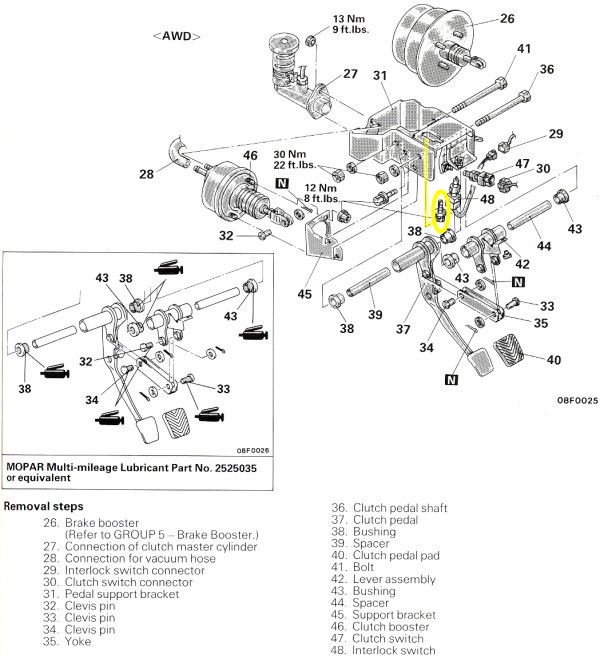Mitsubishi 3000GT / Dodge Stealth Clutch Issue
Loose Pedal Support Bracket Bolt
by Max Taylor
(Web page design and editing by Jeff Lucius)
The Symptoms
It seemed that over a period of time, like 6 months or so, my clutch seemed to be not disengaging fully on my 1992 Dodge Stealth R/T Twin Turbo (this issue affects both FWD and AWD models). This progressively got worse to the point I would have to shut the engine off to get the transmission into first gear if I was not already there due to downshifting before a stop. When stopped, even with the peddle all the way to the floor, the car would creep forward. This let me know that it was still partially engaged. All fluid levels were full and not leaking.
After adjusting the rod on the clutch peddle arm as far as I felt safe, it still had little effect on the situation.
I had also followed all of the checks in my "92 Shop Manual", which I bought when I bought the car brand new in Dec '91. Everything checked out as far as vacuum assist and all. After pulling my hair out when I could not find a solution I had my better half press on the clutch peddle while I had my head up under the dash. While setting there she reached down and picked up something and said "What is this for?". That's when all the pieces fell into place.
Unless you are aware of this problem you will never guess what the cause was. So I'll explain it.
What Happened
Over the 6 months, or maybe years, this bolt had been working its way loose until it finally fell out.
The entire clutch peddle workings are mounted inside a inverted "U"-shaped bracket that is designed to hold all the moving parts (see item 31 in the figure below). This bracket was designed to be installed during the manufacturing process, not afterwards without taking almost everything apart. As such, the bracket has a key-hole type slot in the top and protruding bolts that go through the firewall. If you have a Service Manual, you can look in the Clutch Section to see this slot (see the bolt circled in yellow and the yellow lines in the figure below). The reason for the key-hole slot in the top, which mounts to the underside of the dash is this. Because of the all the shafts and pivots inside this bracket, it is impossible to install the bolt that holds the top of this bracket in place "after" the other bolts going through the firewall are in place. "The Bolt" is inserted, by hand, most of the way into the dash support before the bracket is in place. During factory assembly, the bracket is lifted up, allowing the bolt head to slip through the large part of the key-hole slot, and the entire bracket is slid forward through the firewall with the bolt now in the narrow section of the slot. Then a socket can be applied to the bolt allowing it to be tightened.
Once this bolt is in place it cannot be removed without the entire bracket being bent very much downward, which is exactly what had happened in my case. The bolt probably fell out the very day I was under the dash. Instead of all of the clutch peddle action going to disengage the clutch, half of it was going into bending the bracket downward.

Prevention
If you have not checked the tightness of this bolt lately, do so today! It will save you a truckload of headaches latter on. It probably should be checked yearly.
My fiance also has a 93 Stealth R/T TT and as soon as I found the problem with mine I went straight to hers. And guess what? Yes, it took over two turns on the same bolt to tighten it. This leads me to believe that we probably didn't have the only two Stealths with this problem. Check yours today!
The Fix
Once the bolt falls out you can not put it back in. After a day of trying I gave up. What I finally reasoned was a different type of bolt and lock washer. Because you can't get the original bolt in straight because everything is in the way and you only take a chance of cross-threading it if you use any pressure.
I bought a Cap Head bolt with a Hexagonal Recess that was slightly shorter than the original bolt (there are plenty of threads available). Then, I cut off the long side of an Alan/hex wrench that fit the recess in the head, inserted it into a small socket on an extension handle, and placed the bolt on the end of all this [Ed. note: A bit of masking tape can be used to secure the bolt to the hex key]. With much difficulty, because space is very tight, I was able to get it threaded straight into the existing threads with nothing more than finger pressure. DO NOT FORCE THIS BOLT. Cross-threading this bolt will mean major, major problems. [Ed. note: For more information regarding fasteners, please see the file fastener_training_manual.pdf in the folder http://stealth316.com/misc/index.html.]
Once tight, all the clutch problems disappeared instantly. The only thing left to do was adjust the rod so that I had proper play at the top of the clutch peddle.
I hope this can be of help to others out there that can't seem to figure out why their clutch is not disengaging.
Sincerely,
Max Taylor
Page last updated August 17, 2006.

